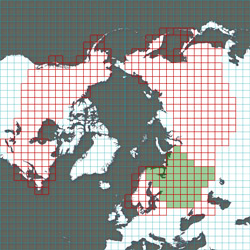|
Boreal forests are a critical component of the global carbon cycle, and timely monitoring is required for assessing forest cover change and its impacts on carbon dynamics. However, existing pan-boreal forest biome monitoring information is lacking and existing national scale forest area statistics are incomplete and inconsistent. Satellite remotely sensed data provide a practical and comparatively inexpensive solution for periodic monitoring of boreal forest cover. Landsat imagery, provided free of charge by the USGS Center for Earth Resources Observation and Science enable consistent and timely forest cover updates at biome scales. However, irregular image acquisition within parts of the boreal biome coupled with an absence of atmospherically corrected data presented a unique challenge for pan-boreal Landsat-based forest monitoring.
|
|
The presented dataset has been created in Geographic Information Science Center of Excellence (SDSU) using a new automated approach for Landsat image processing and compositing. The method employs a multi-year compositing methodology adapted for unequal image inputs based on differing data availability due to variations in growing season length and number of image acquisitions. Relative radiometric normalization and cloud/shadow data screening models were employed to create seamless radiometrically consistent image mosaics with little or no cloud contamination. Supervised classification tree algorithms were applied to the time-sequential image composites to characterize forest cover, gross forest loss and gain over the study period. For a complete algorithm description please refer to our publication (currently in review): Potapov P., Turubanova S., Hansen M.C. (in review) Regional-scale boreal forest monitoring using Landsat data composites: first results for European Russia. Remote Sensing of Environment.
The dataset consists of Landsat image composites for circa year 2000 (created using data from 1999 to 2002) and circa 2005 (created using data from 2003 to 2005). Only 3 image bands for each time interval are included in the on-line dataset. Other spectral bands, image date layers and additional annual metrics used for data analysis are available on request. The Landsat-based classification results showing forest, non-forest classes for year 2000 and forest cover change from 2000 to 2005 are available for cross-validation and analysis. Our to-date validation result illustrates that regional-scale Landsat monitoring results are comparable with heritage individual image supervised characterizations. However, note that forest cover gain results were not validated, could have high uncertainty, and should be considered preliminary. Our current dataset includes only data for European Russia from 2000 to 2005. The authors envision that the dataset will be expanded in space to cover the entire pan-boreal biome, as well as the 2000-2010 interval.
|

Example of Landsat year 2000 and 2005 composites, and forest cover monitoring product (green - forest cover, red - forest over loss)

Circumboreal Landsat composite tiling system. Blocks outlined in red will be included in the Boreal Forest Monitoring. Blocks highlited in green are available for download
|
|
| The first results of independent satellite-based monitoring of boreal forests are an important tool for providing transparent information on forest change. Government officials, land managers, researchers, conservationists, and civil society groups can use such information to make better-informed decisions regarding the management of boreal ecosystems.
For further information, please contact: |



